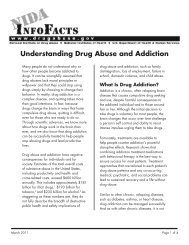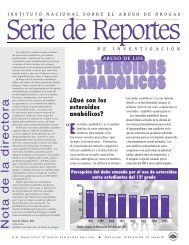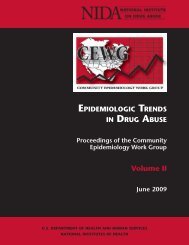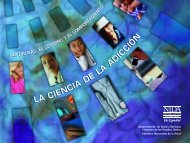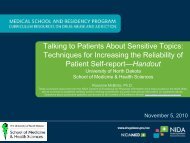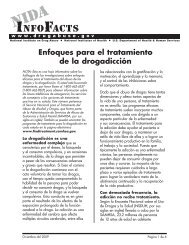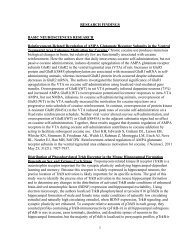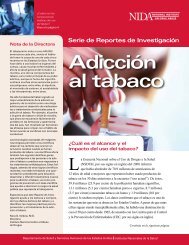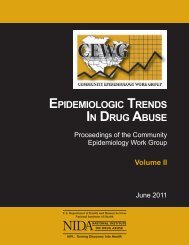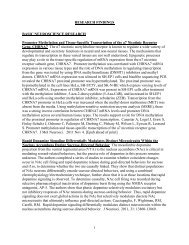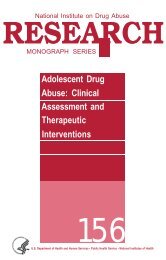CEWG January 09 Full Report - National Institute on Drug Abuse
CEWG January 09 Full Report - National Institute on Drug Abuse
CEWG January 09 Full Report - National Institute on Drug Abuse
Create successful ePaper yourself
Turn your PDF publications into a flip-book with our unique Google optimized e-Paper software.
EpidEmiologic TrEnds in drug AbusE: HigHligHTs And ExEcuTivE summAry<br />
2008 reported problems with marijuana, powder<br />
cocaine, alcohol, and heroin, while higher<br />
proporti<strong>on</strong>s of n<strong>on</strong>border clients reported<br />
problems with crack/cocaine, methamphetamine,<br />
and other opiates (figure 10). The Texas<br />
representative also pointed out that treatment<br />
admissi<strong>on</strong>s exhibit regi<strong>on</strong>al variati<strong>on</strong> from east<br />
to west al<strong>on</strong>g the Texas border, with cocaine the<br />
most comm<strong>on</strong>ly reported primary drug problem<br />
in the Lower Rio Grande Valley, marijuana<br />
in Laredo, and alcohol in El Paso.<br />
• In New Mexico, 1,588 unintenti<strong>on</strong>al drug pois<strong>on</strong>ing<br />
deaths were reported during 2003–2007,<br />
a death rate of 16.5 per 100,000 populati<strong>on</strong>. The<br />
New Mexico representative reported that compared<br />
with n<strong>on</strong>border counties, border counties<br />
in New Mexico had significantly higher death<br />
rates per 100,000 from any illicit drug, any prescripti<strong>on</strong><br />
drug, prescripti<strong>on</strong> opioids other than<br />
methad<strong>on</strong>e, and antidepressants.<br />
• The Phoenix area member presented a comparis<strong>on</strong><br />
of hospital admissi<strong>on</strong>s per 100,000 populati<strong>on</strong><br />
in 2007 in Pima County, situated al<strong>on</strong>g the<br />
Mexico border, and Maricopa County, a n<strong>on</strong>border<br />
county in which Phoenix is located. The<br />
border county had higher hospital admissi<strong>on</strong>s<br />
rates for cocaine and heroin/opioids than the<br />
n<strong>on</strong>border county (figure 11).<br />
• The Phoenix representative also referred to<br />
marijuana and heroin traffcking and prescripti<strong>on</strong><br />
drug smuggling north from Mexico into<br />
Ariz<strong>on</strong>a, arms traffcking south into Mexico,<br />
and violence in the Ariz<strong>on</strong>a–Mexico border<br />
area. It was reported that recent seizures in<br />
Phoenix indicate that some drug traffckers<br />
may be using the area as a distributi<strong>on</strong> point for<br />
white heroin from Mexico destined for other<br />
areas of the United States.<br />
• The representative from Mexico reported a different<br />
pattern of substance abuse in Mexican<br />
states bordering the United States, compared<br />
Figure 11. Amphetamine, Cocaine, and Heroin/Opioid-Related Hospital Admissi<strong>on</strong>s per 100,000<br />
Populati<strong>on</strong>, Pima and Maricopa Counties, Ariz<strong>on</strong>a: 2007<br />
Admissi<strong>on</strong>s per 100,000 Populati<strong>on</strong><br />
35<br />
30<br />
25<br />
20<br />
15<br />
10<br />
5<br />
11.4<br />
9.6<br />
31.7<br />
7.8<br />
Pima<br />
Maricopa<br />
20.0<br />
10.2<br />
0<br />
Amphetamine Cocaine Heroin/Opioid<br />
Source: The University of Ariz<strong>on</strong>a, Department of Family and Community Medicine, as reported by James Cunningham at the <str<strong>on</strong>g>January</str<strong>on</strong>g> 20<str<strong>on</strong>g>09</str<strong>on</strong>g><br />
<str<strong>on</strong>g>CEWG</str<strong>on</strong>g> meeting<br />
24<br />
Proceedings of the Community Epidemiology Work Group, <str<strong>on</strong>g>January</str<strong>on</strong>g> 20<str<strong>on</strong>g>09</str<strong>on</strong>g>



